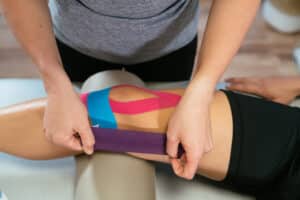Tape
The Tape
Since the 80s, elastic tape has become an integral part of sports. Japanese and Korean athletes caused a sensation at the Olympic Games with these colorful plasters.
It is not only used in sports as a supportive measure for injuries. It is now also used in various disciplines in neurology, lymphology or orthopedics. Elastic tape influences pain receptors and lymphatic drainage. It supports and stabilizes the injured region.
The origin of the tape method
The elastic tape method originates from Japan and should complement the rigid tape. Many techniques could be newly developed and combined. It was not only the immobilization in the foreground, but one could consciously support different joints with it and also mobilize. The tape was therefore developed with Far Eastern thought and philosophy. The basis is kinesiology.
What is the elastic tape?
Specially developed, elastic tape of skin-friendly quality are applied to the muscle so that they stimulate sensorimotor function and metabolism. Depending on the need, it is applied detonating, that is, with a calming effect on the muscle, or toning, that is, activating the muscle. Toning means it is applied from the muscle origin to the muscle insertion. To detonate from the muscle insertion to the muscle origin. Thus, pain and movement restrictions can be successfully treated. The beautiful colorful tape has in most cases replaced the white inelastic sports tape. There are many different colors, they are said to have different properties, which is not scientifically proven.
There are many different investment options. These are selected after a thorough analysis of your problem.
- Muscle techniques
- Ligament techniques - at the knee e.g.: to support the inner ligaments
- Correction techniques - on the knee e.g.: to correct the kneecap
- Fascia techniques - at the thigh e.g.: to get tension out from the Fascia
- Lymphatic techniques - on the ankle e.g.: after supination trauma to better drain the swelling.
- Neural techniques - after lesions or irritations or sensations
- functional taping - nerve taping e.g.: carpal tunnel syndrome
- Scar techniques - taping on the scar to make it more elastic
Effect of the elastic tape
Body's own self-healing forces are activated by the tape, it represents a positive sensory effect on the skin and thus on the body. Microcirculation is also improved. Lymphatic drainage and local blood circulation is increased. By sticking it on the skin, receptors such as the proprioceptors are stimulated, which improve the feeling of movement and optimize the motion sequences. This can be particularly helpful post-operatively or in sports after an injury. Also an improvement of the statics is possible by the tape one can have influence also on the muscle tonus. Especially a posture tape between the two shoulder blades can help against a crooked posture at the desk.
Influence on the lymphatic system
The so-called Lymphtape is excellent after acute injury or surgery to minimize swelling as quickly as possible. The first goal after surgery or injury is to control swelling and inflammation. We often use it in combination with lymphatic drainage, as both measures positively reinforce each other. Lymphatic drainage as both measures positively reinforce each other.
- The lymphtape is used in the head and neck area after jaw, nose or tooth surgery
- in the shoulder, arm and breast area after surgery or removal of lymph nodes in the armpit.
- on the trunk after radiation or lymph nodes were removed in the groin area.
- around a scar to positively influence the scar and to support the metabolism, thus the healing.
What is a sports tape
This is a white, inelastic tape that is quickly applied by a physiotherapist, e.g. in competitions, in order to stabilize a joint and so that the athlete remains able to bear weight for a certain time. After the load, it should be removed.
However, it can also be applied as a preventive measure to prevent injuries such as twisting an ankle.
When should not be taped?
Especially for acute or chronic skin diseases, malignant tumors, vascular pathologies, allergies, irradiated skin areas or excessive skin irritation after sunbathing. it is not recommended to apply the tape to the affected areas. You should discuss this with your therapist.

